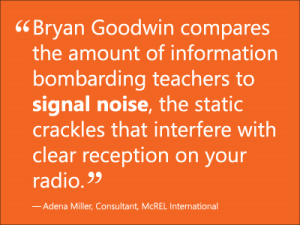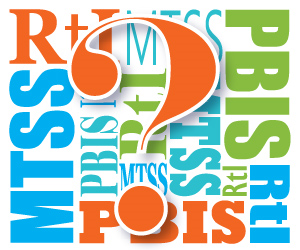If your state is anything like Colorado, Florida, or Michigan, an educational revolution is occurring—or perhaps it would be more apt to say, an evolution is occurring—with districts making the shift from using Response to Intervention (RtI) and Positive Behavior Interventions and Supports (PBIS), to using Multi-Tiered System of Supports (MTSS).
If you’ve been in education for any length of time, you’ve seen many innovations and initiatives come and go. In the book Simply Better: Doing What Matters Most to Change the Odds for Student Success, Bryan Goodwin compares the amount of information bombarding teachers to signal noise, the static crackles that interfere with clear reception on your radio. He writes, “…the preponderance of reports, information and ideas in the field of education may have the effect of drowning out the big ideas—the key underlying principles of what’s most important when it comes to improving the odds for life success for all students.”
So, is this shift from RtI and PBIS to MTSS simply static leading to more confusion, or is it more significant than that? To gain some insight, let’s take a look at the traditional use of the terms and the implications for educators today.
RtI gained popularity after the reauthorization of the Individuals with Disabilities Act (IDEA) in 2004, which prompted educators to identify students with specific learning disabilities by measuring their response to scientific, research-based instruction. While there’s no commonly agreed upon definition of RtI, there is general consensus that the framework should include a multiple tiers of instruction and interventions, and the use of data and assessment to inform decisions and problem-solving at each tier. Ideally, RtI is a preventative, proactive, school-wide framework designed to address efficiently the needs of all students with an appropriate level of intensity to ensure strong outcomes.

Both RtI and PBIS have great strengths and research to support their use, but each also suffers from serious misconceptions. Because of the emphasis on using RtI for identifying students with learning disabilities, in many places it has become a set of hoops to jump through to get kids into special education, rather than a framework for addressing the needs of all learners. PBIS, on the other hand, is often misunderstood to be a ‘token economy’ with the use of tangible rewards for motivating students to do what they should be intrinsically motivated to do, rather than the direct instruction of behavioral expectations and providing students with descriptive feedback on how they are doing.
Another common point of confusion is whether RtI is inclusive of behavior and social-emotional interventions, or if those are a part of a separate system. In schools that problem-solve academics separately from behavior, students are sometime discussed in great depth by two different groups of people, both with great intentions, but not communicating and collaborating effectively. The end result: two sets of interventions not leveraging the benefits of each other (and sometimes working at odds with each other).
And that’s where MTSS comes in. Proponents like the name better than RtI, because it describes what the framework really is about—a multi-tiered system designed to support student outcomes; it’s what we should have called it from the start. Additionally, MTSS integrates academic and behavioral supports. In other words, rather than problem-solving academics in one room and behavior in another, teams work together to consider how academic challenges may influence observed behaviors, and vice-versa (whether for the whole school, small groups, or individuals). Other than that, the key characteristics of RtI and MTSS are the same: use of a continuum of evidence and research-based instruction and intervention practices to support students across all school settings; using relevant data or information to effectively and efficiently problem-solve; and establishing a continuum of practices and systems.
Now, we find ourselves back at the original question: Is this a revolution or an evolution? I think the answer is: It depends on how RtI and PBIS have been used in your school or system. If your educators see RtI as a means for getting students into special education, or if your teams consider behavior in isolation from academics, then this shift to MTSS is probably significant. However, if your implementation looks a lot like the definition of MTSS (integrated, preventative, problem-solving approach), then the shift is likely mere semantics.
Either way, what matters most in the end is not what we call it, but what we actually do and the results we achieve for our students.



Hi Dr. Miller,
Thank you for your post on the topic of MTSS/RtI. My school has recently began to redefine the RtI process. During professional development it has been explained to us that the RtI process is not a road to get students into Special Education, the exact same idea that you write of. The way that the shift is being rolled out has received flack. I think it is because teachers are still confused as to how many interventions are needed or how much time is needed before Special Education is considered. I forwarded your blog post to my P.D. coordinator and my team. I’m curious to know why my coordinator did not show us this information to begin with. Perhaps if she did, than she wouldn’t be receiving so much resistance from educators at our school. Either way, reading your post has clarified a lot for me.
Thank you again,
Asia Lyons
Hi Dr. Miller,
Our school is currently looking at ways to improve our intervention model. Our intervention team presented data at a staff meeting earlier this year and what they found was that students who entered our intervention program in the primary grades rarely leave. This tells us that they are not improving with the current strategies we are using. This now has us analyzing our RtI model.
I need to think deeper on how our school responds to student needs- do we separate academics from behavior? This is a very important element to be aware of as we proceed with re-structuring our intervention program.
Thank you for this article.
Anne G.
Hi Anne G.,
Thank you for your thoughts here. In addition to what you’ve proposed, I would also encourage you to think about whether you have all of the elements of an effective intervention system in place. For example, use of assessment data in a timely manner for problem-solving purposes is crucial. Questions you might consider regarding academic and behavioral interventions might include : Are we using diagnostic measures to pinpoint specific student needs and then matching interventions to those needs? Or, are we providing the same generic set of interventions to all students who are behind without knowing whether those are best aligned to student challenges? Are we monitoring student progress frequently for those receiving interventions and making adjustments to maximize growth? Are we ensuring students are actively engaged during intervention times and being prompted to apply what they’ve learned into other settings?
I’d be happy to be a thought partner with you and your team as you problem-solve and re-structure your intervention programs.
Best of luck, and thank you again for your thoughts,
Adena
Thank you for your wonder clarification of these concepts.